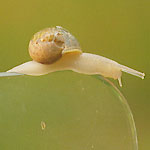Snails, Slugs and Slime
Snails and slugs are very successful members of the mollusc family. They have brown or grey, soft, unsegmented bodies and two pairs of retractable tentacles on their heads. Slugs have an obvious ‘saddle’ or mantle, while snails have a spiralled shell. Snails and slugs move by gliding along on a muscular ‘foot’. This muscle constantly secretes mucus, which later dries to form a silvery trial of slime.
Slimy progression
As a snail or slug moves, waves of contractions ripple along its muscular foot. The foot is lubricated with mucus or slime, which liquifies and becomes slippery under pressure from the foot. When the wave of pressure passes, the mucus solidifies again, forming an effective glue. This process both propels the animal forward, and prevents it slipping backwards.
Slime is used to help snails and slugs navigate, and to climb steep or difficult terrain, such as the pane of glass in our segment. Slime also plays an important part in the mating rituals of both slugs and snails. Some species of slugs hang by a thread of mucus when they mate. Common garden snails fire mucus-tipped ‘love darts’ at each other just before mating. It is thought that the mucus on the darts contains a pheromone which facilitates fertilisation.
Slugs and snails in the garden
Introduced brown garden snails (Helix aspersa) cause damage to plants with their rasping tongues, which are covered with 15,000 teeth. Small, introduced species of slugs also cause lots of damage in the vegie patch. Methods of control include:
Using snail pellets. They are effective, but toxic to wildlife and pets. Be very careful using snail bait if you have a dog, as dogs find it particularly attractive and it can kill them if they eat it. Birds and lizards can also be poisoned by eating snails that have eaten snail baits. Removing the snails and slugs by hand. This is best done at night with a torch. Encouraging blue tongue lizards to live in your garden by providing logs and rocks for them to hide under (and not using snail baits). Placing containers with a small amount of beer in the garden. This attracts slugs and snails, which then fall into the dish and drown.



